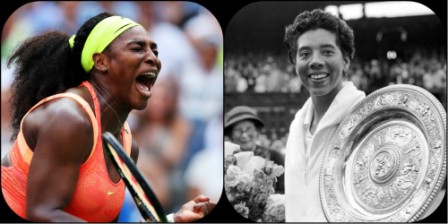SERENA, the Althea of our times
New York
--
As Serena Williams left the interview room Monday evening and walked down a long corridor, I asked her if she had seen the Althea Gibson documentary that is making the rounds. “Just got it,” she said, pointing to her bag. “I'm looking forward to watching it.”
I'm not sure if Williams should watch the film at such an emotional time or just wait until her run at a Grand Slam is over. The story of Gibson, the great tennis champion who died in 2003 and would have been 88 on Aug. 25, dredges up anger, inspiration and gratitude.
I have watched “Althea“ three times. Each time, the connection between Williams and Gibson becomes clearer. Past to present; present to past.
At a willowy 5 feet 11, Gibson was built more like Serena Williams's sister Venus. But Gibson's temperament – the fire, the passion, the laser focus, the take-no-prisoners approach – was a precursor to Serena's. As a teenager, she was more comfortable in Harlem pool halls and bowling alleys than in classrooms. Althea Gibson was her generation's Serena Williams, and vice versa. Gibson's Harlem was Williams's Compton.
Who would win a match between them? I rarely get into such historical conjecture. But after watching and rewatching “Althea,“ which will be shown on PBS on Friday, a match between them in their primes would have been one for the ages. No one budging, no one giving in – Gibson because that is how blacks of her era survived, Williams because that's just the way she is.
“Althea was a serve-and-volleyer; very, very aggressive; big wingspan; built more like Venus than Serena,“ Rex Miller, who produced “Althea,“ said in a recent interview. “Give Althea the same equipment, a little more coaching, time to get familiar with the modern game: It would have been a real matchup.“
Gibson discovered education later in life, graduating at age 26 from Florida A&M, which she attended on a tennis scholarship. She was an incredible table tennis player, played the saxophone, cut an album, became a professional golfer and even starred in a western with John Wayne. “I was just amazed with all the things that she did,“ Miller said.
With each viewing of “ Althea,” I also came away with an unshakable sadness. Her life, while triumphant, did not have a happy ending. Tennis was not the multimillion-dollar bonanza it is today, and those volatile times were not right for a woman, particularly a black woman.
Things change, but often not quickly enough. Serena Williams is currently the beneficiary of a love fest, though this has not always been the case. Many of those throwing roses along Williams's path to glory once threw darts. There has been criticism over her angry outbursts, questions about whether she played in enough matches each year and even her body type.
Largely because of the extraordinary amount of prize money available and earned, Williams has had opportunities outside tennis that Gibson could not have imagined. Gibson once was even forced to undergo a chromosome test to ensure that she was a woman.
On the court, doubts about whether Gibson could play were erased by her talent. Gibson came on the scene in 1950 at Forest Hills, though only after considerable lobbying that she be allowed to compete. From 1956 until her retirement in 1958, Gibson was acknowledged as the world's top female tennis player.
Many of her struggles came after her tennis career as she struggled to find a comfort zone. She played tennis exhibitions and provided halftime entertainment at Harlem Globetrotters games. In 1964, she joined the LPGA Tour. She was a tremendous singer, made one album. There were marriages and divorces. Late in life she became destitute, and only through the benevolence of a friend who made her plight public did Gibson receive more than $1 million in donations. “She did somewhat isolate herself, and then the white game of tennis was quick to kind of brush her aside,” Miller said.“And she helped.”
I cannot imagine Serena Williams ever being lost in history . Her numbers are too impressive, and she is making too much money for tennis to ever forget her. According to the USTA, the women's final sold out before the men's this year for the first time. This is the Serena effect.
Serena Williams, who as a seventh grader once faxed Gibson a list of questions as part of a school assignment, has built a castle in Gibson's honour.
Perhaps, in this respect, we can watch “Althea“ and, because of Serena Williams, celebrate a life well lived and more castles to come.
Related Posts

